Thanks ! At least now I know why ! Can the Samsung 960 EVO NVMe SSD firmware be updated to include the 950 Pro legacy drivers to boot to a point that it can load the NVMe needed drivers ? That seems easier than modding the BIOS if it works with all the legacy systems. Is there a good reason for removing the support for legacy systems ? And if Clover can add all the files in barely 14MB that it could be easily added to both the SSD firmware and BIOS.
Do you mean a Samsung NVMe SSD or the AHCI versions. Since I know the AHCI version would work.
Samsung should just add the NVMe driver !
@Tony54 :
Please stay on-topic!
Since you obviously are not satisfied to boot permanently off a separate USB Flash Drive using the Clover-Method, I have moved your recent discussion into this thread.
Why don’t you just follow the guide within the start post of this thread? It is very simple and not risky at all, if you follow my advices.
There is no other way, if you want to boot off your Samsung 960 EVO and use it as system drive. Neither Samsung nor anyone else will make your NVMe SSD bootable with your Intel 7-Series chipset system. You can and have to do it yourself!
Just subscribed to say thanks. My system just died and I used an old Tyan S5510 mb while I get new parts. Took the risk to add nvme and it is working flawlessly.
950 PRO / PCIe2@4x
Sequential (MB/s)
Read: 1,458
Write: 966
Random (IOPS)
Read: 239,746
Write: 80,566
@Fernando
Thanks for your help. However, I have some trouble to replace the PE32 body of the DXE module named ‘nvme’ because this BIOS does offer several ‘nvme’ related modules.
I have tried to mod the two ‘nvme’ occurences and did not succeed. Moreover I get a final error pop up:
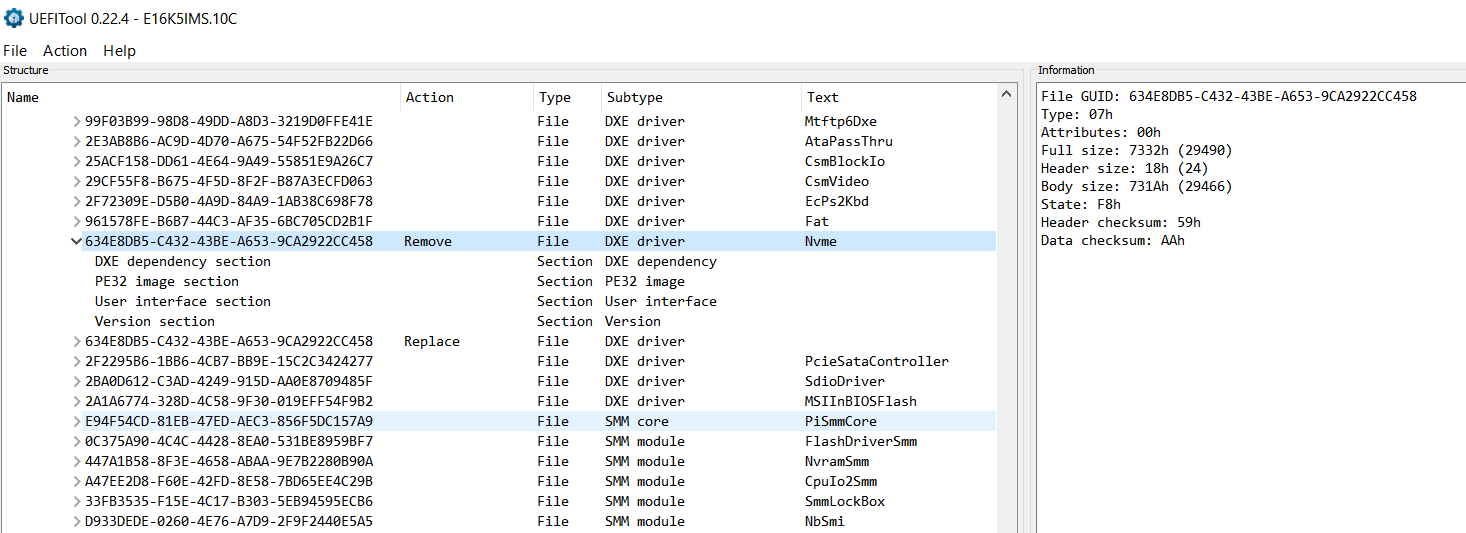
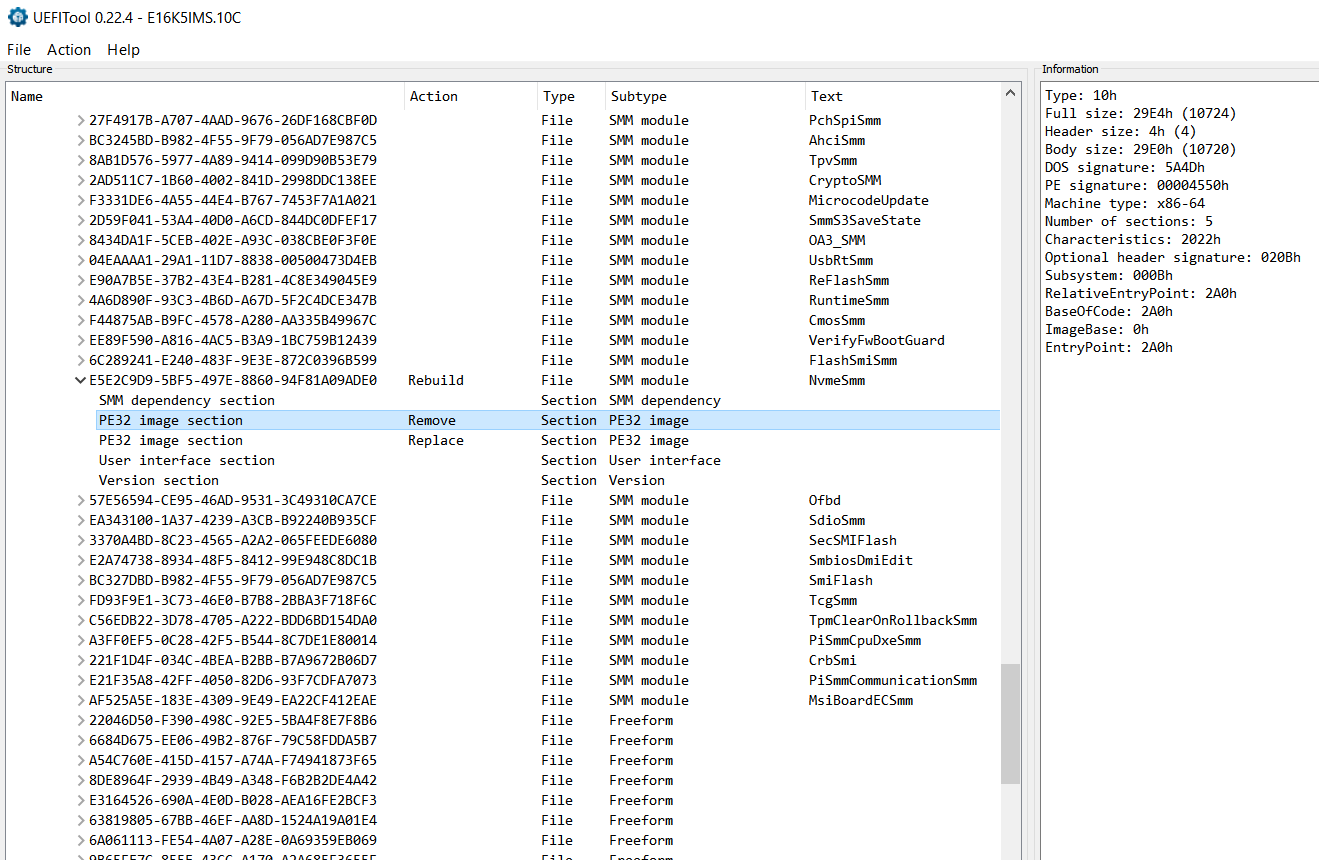
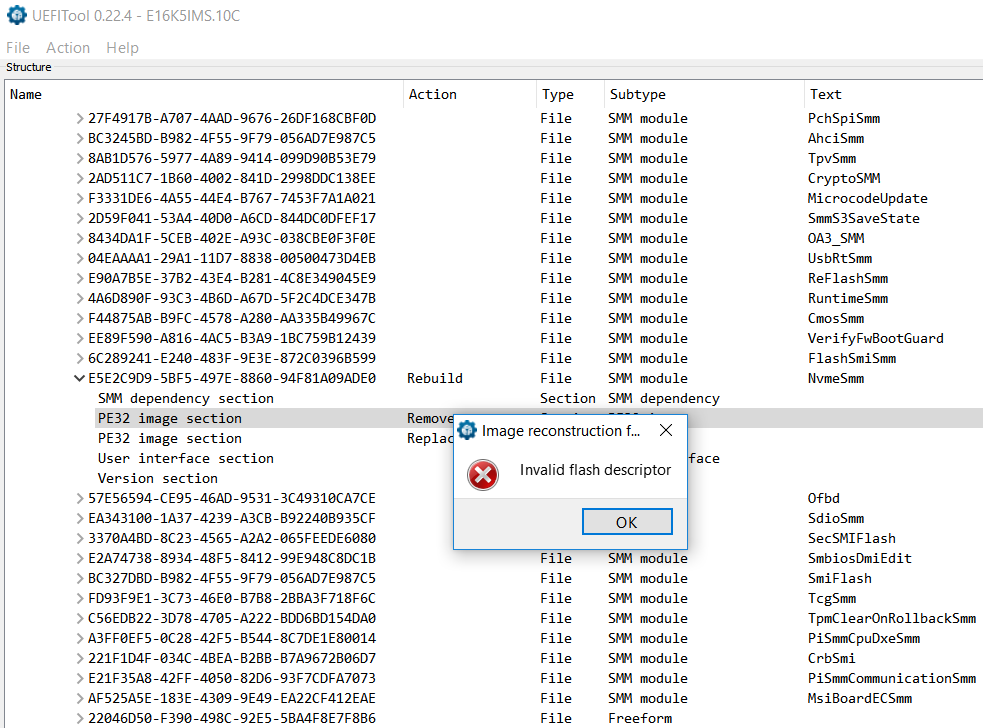
I have tried to use carefully the Start post Guide Line, but the first thing i do observe is there is no “Compressed Section” of the “DXE driver” (which one doesn’t matter)" as described in the Guide Line. Strange ?
So, I have attached a .ZIP file of the BIOS to be modded.
Moreover, i don’t understand what is the .10C extension, and trying to flash the original BIOS slightly modded by UBU tool is not accepted by the MSI flash procedure under the BIOS menu interface (checksum error).
So, lot of difficulties to mod and flash a MSI BIOS compared to a ASUS BIOS using the very easy Flash Back button (not offered on a MSI machine).
Thanks in advance for your help.
E16K5IMS.zip (5.08 MB)
No, there is just one DXE Driver named “Nvme” within the BIOS. You should not modify the SMM module named “NvmeSmm”.
Only the DXE Driver module named “Nvme”, which has similar functions as the NvmExpressDxe_4 module, should be modified (right-click onto the “PE32 image section” line and choose the option “Replace body”).
Another option, which may be less risky, is to remove the DXE Driver module named “Nvme” and to insert the complete DXE Driver file "NvmExpressDxe_4.ffs according to my guide instead.
Keep in mind, that the PC may not be bootable anymore thereafter (whichever option you may choose), but a reflash of the previously used BIOS should solve this issue.
@fernando,
Thanks for your help.
However, I tried the less risky option, remove the DXE driver named "Nvme" and to insert the complete DXE Driver file "NvmExpressDxe_4.ffs" according the Guide , but I get the "Invalid Flash Descriptor" Error message.
So, I did not succeed modding the Nvme module. Do you see why ?
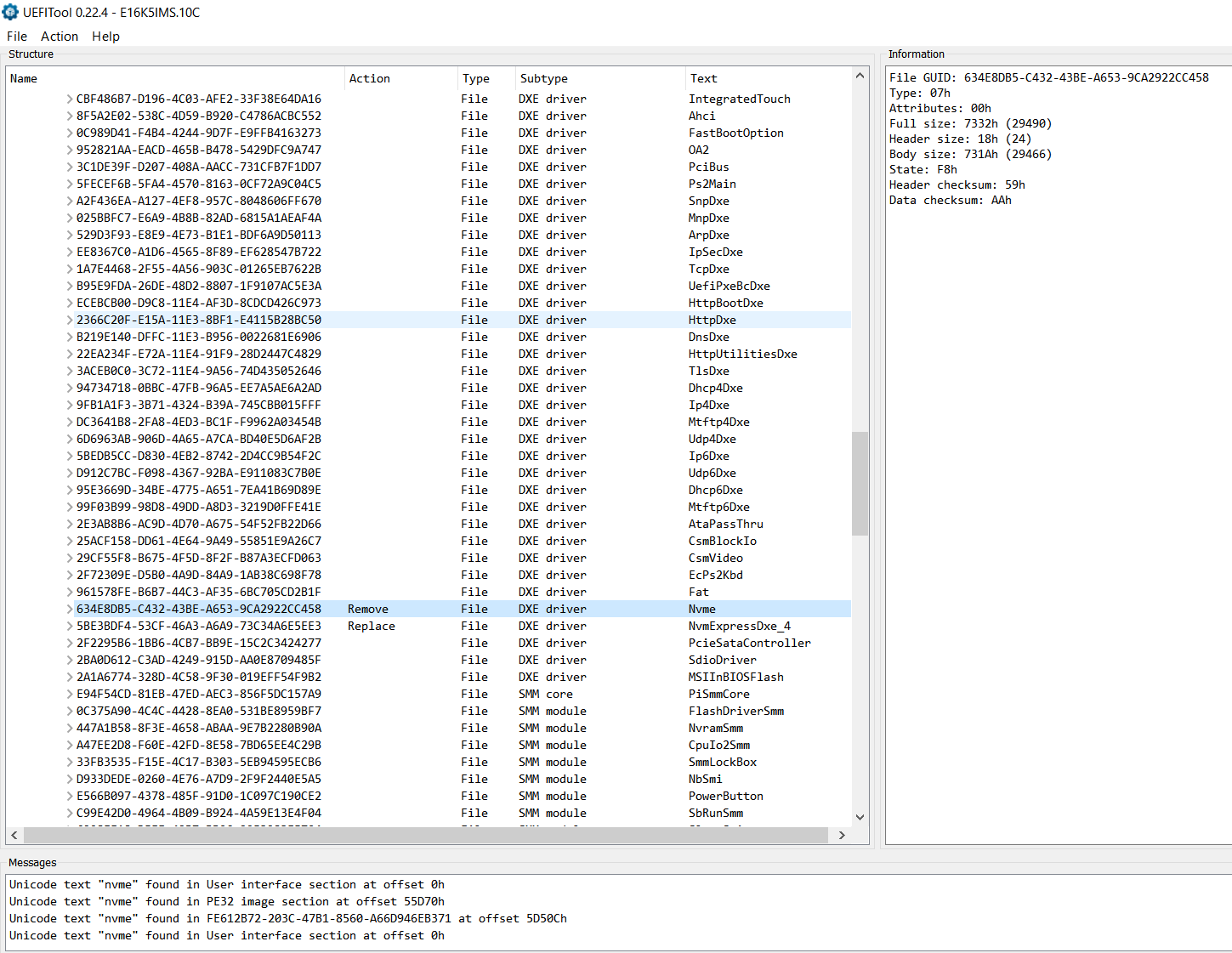
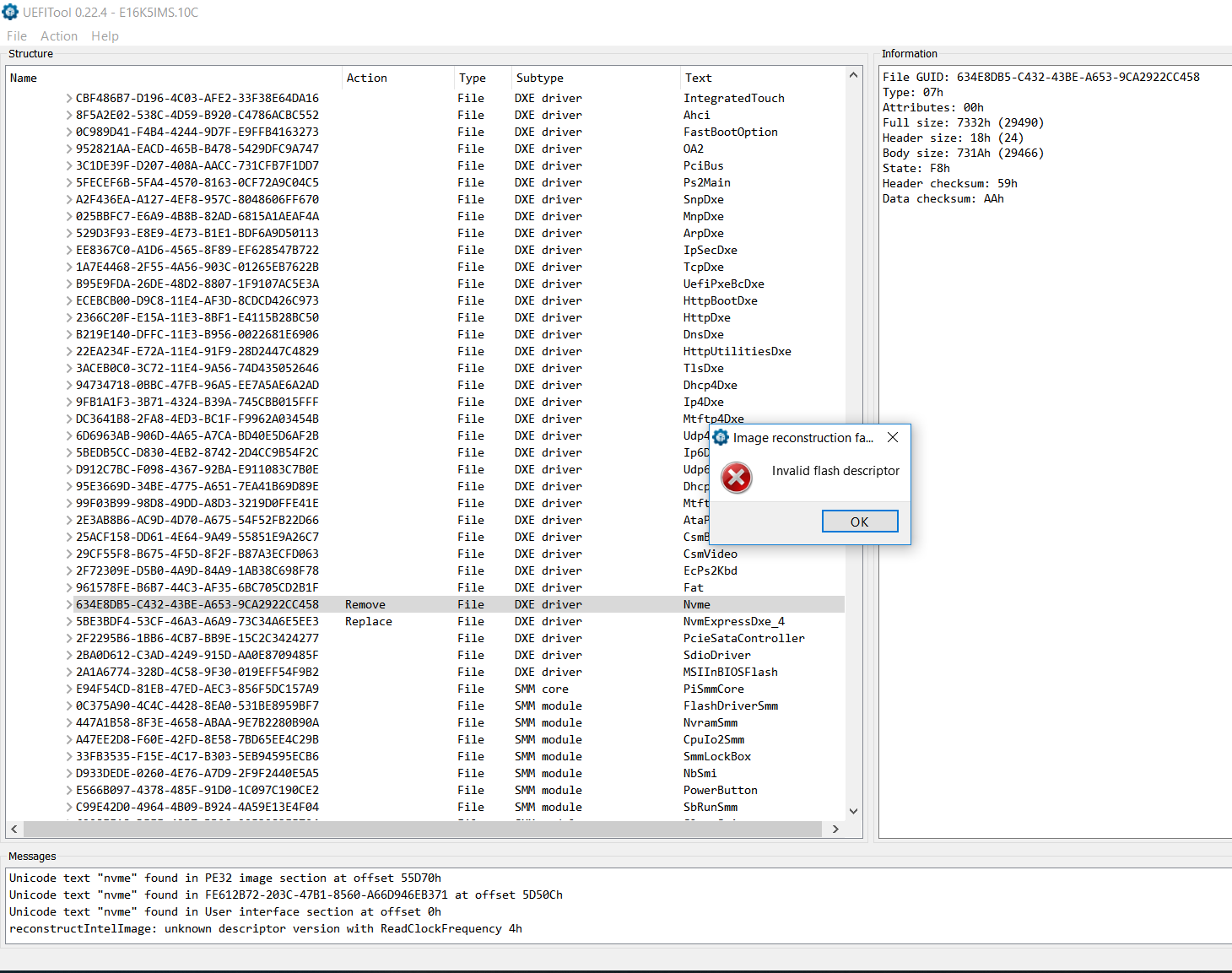
@100PIER :
You got the error message, because you tried to simply replace the “Nvme” module by the “NvmExpressDxe_4” one. That doesn’t work.
After having removed the Nvme module you should store the modded BIOS and then insert the NvmExpressDxe_4.ffs file behind the undermost listed DXE Driver (as written within my guide).
@Fernando
After the remove operation I tried also the "store" operation you do recommend (as I do not see "store" I assume you speak about a "save image file.." operation, is it correct ?).
The "save image file…" operation does produce the stucky error message "Image Reconfiguration failure, …"
So, I do not progressed. Any idea ?
If you have some time to try a test with the BIOS file I had attached previously and have a look if this BIOS is really moddable or not (for some unknown reasons) ?
I will do that as soon as I have the required time.
@Fernando
Heee, your startup GuideLine does offer a obsolete UEFITool version that does not work with MSI BIOS file !!
When using UEFITool v0.25.1 I no longer get the Image Record Failure !
I founded the proper UEFITool v0.25.1 into the last UBU Tool Dev_19 folder.
I am surprise why you refer to UEFITool file which is half size of the best current v0.25.1…
You should fix the proper link into the Guide Line at the start up post.
Done!
I have started so many threads and nearly all of them have to be updated frequently - I cannot avoid mistakes like this one…
@bskchaos :
Welcome to the Win-RAID Forum and thanks for your feedback!
Enjoy the performance of your NVMe SSD!
Dieter (alias Fernando)
@davidm71
I used a obsolete UEFItool version not working with MSI BIOS. I reported the problem to Fernando, and he has now fixed with the proper link into the start up post Guide LIne to offer now UEFItool v0.25.1.
v0.25.1 does fix the MSI BIOS compatibility problem when usin v0.22.4.
Good to know. Going to replace every version I have to 0.25.1. Thanks.
I doesnt really know what settings I have to change in the BIOS, after flashing the mobo with the modded BIOS.
( P8Z77-V Pro/thunderbolt)ä I have set everything as before, but I guess I need to di some boot settings for pcie or uefi ?
The ones that I can see possibly affecting this issue:
( fast boot= enable/disable)
Under CSM( compabiliry support mode) :
Launch CSM= Auto/enabled/disabled
Boot device control = UEFI and Legacy opROM / Legacy opROM only/ UEFI only
Boot from storage devices= Both, Legacy opROM first/ Both, UEFI first/ Legacy opROM first/ UEFI driver first/ ignore
Boot from PCIe/PCI Expansion devices= Legacy opROM first/ UEFI driver first
Thers also another for boot from Network devices, but it shouldnt matter?
Can I see in the BIOS that the mod is OK?
@AAKEE :
These are the settings I would try at first:
“Fast Boot”: Disabled
“LAUNCH CSM”: Enabled
“Boot Device Control”: UEFI and Legacy opROM
“Boot from Storage Devices”: UEFI driver first
Note: Don’t forget to DISABLE the “Secure Boot” option (may be available within the “Security” setion of the BIOS)
Yes, it doesn’t matter.
Yes, you should see a device named “PATA SS” (or similar).
Thanks very much, now it works.
Found another site that claimed ”fast boot disabled” and ”CSM disabled”.
I went for this and now windows 10 is installing.
I would rather like to use an option to move the existing OS( like samsung data migrator) but it didnt work before anyway( to save time during fine summer days and do the clean install later). I dont know why, I could see and select the samsung 970 evo as target drive.
[Edit]installation of w10 did work, but no boot afterwards. Can not see Pata SS or something like in the boot options so I need to check the modded bios again.